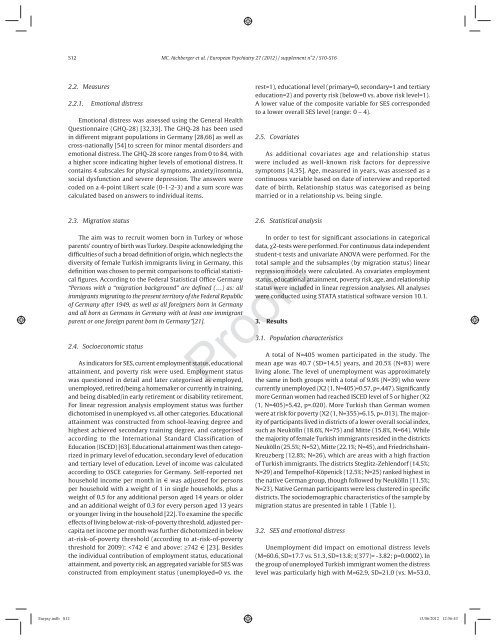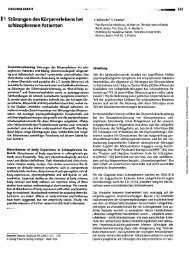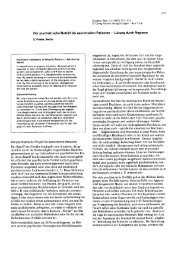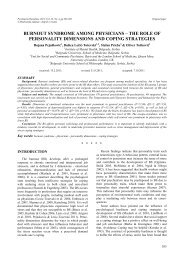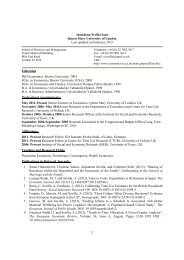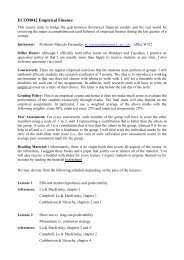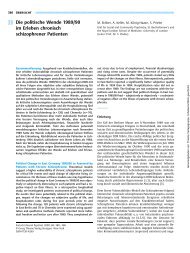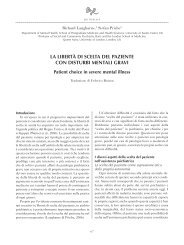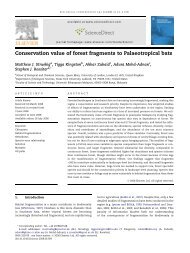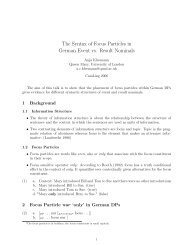Proofs - Personal Webspace for QMUL - Queen Mary, University of ...
Proofs - Personal Webspace for QMUL - Queen Mary, University of ...
Proofs - Personal Webspace for QMUL - Queen Mary, University of ...
Create successful ePaper yourself
Turn your PDF publications into a flip-book with our unique Google optimized e-Paper software.
S12 MC. Aichberger et al. / European Psychiatry 27 (2012) / supplement n°2 / S10-S16<br />
2.2. Measures<br />
2.2.1. Emotional distress<br />
Emotional distress was assessed using the General Health<br />
Questionnaire (GHQ- 28) [32,33]. The GHQ- 28 has been used<br />
in different migrant populations in Germany [28,66] as well as<br />
cross- nationally [54] to screen <strong>for</strong> minor mental disorders and<br />
emotional distress. The GHQ- 28 score ranges from 0 to 84, with<br />
a higher score indicating higher levels <strong>of</strong> emotional distress. It<br />
contains 4 subscales <strong>for</strong> physical symptoms, anxiety/insomnia,<br />
social dysfunction and severe depression. The answers were<br />
coded on a 4- point Likert scale (0- 1- 2- 3) and a sum score was<br />
calculated based on answers to individual items.<br />
2.3. Migration status<br />
The aim was to recruit women born in Turkey or whose<br />
parents’ country <strong>of</strong> birth was Turkey. Despite acknowledging the<br />
diffi culties <strong>of</strong> such a broad defi nition <strong>of</strong> origin, which neglects the<br />
diversity <strong>of</strong> female Turkish immigrants living in Germany, this<br />
defi nition was chosen to permit comparisons to <strong>of</strong>fi cial statistical<br />
fi gures. According to the Federal Statistical Offi ce Germany<br />
“Persons with a “migration background” are defi ned (…) as: all<br />
immigrants migrating to the present territory <strong>of</strong> the Federal Republic<br />
<strong>of</strong> Germany after 1949, as well as all <strong>for</strong>eigners born in Germany<br />
and all born as Germans in Germany with at least one immigrant<br />
parent or one <strong>for</strong>eign parent born in Germany”[21].<br />
2.4. Socioeconomic status<br />
As indicators <strong>for</strong> SES, current employment status, educational<br />
attainment, and poverty risk were used. Employment status<br />
was questioned in detail and later categorised as employed,<br />
unemployed, retired/being a homemaker or currently in training,<br />
and being disabled/in early retirement or disability retirement.<br />
For linear regression analysis employment status was further<br />
dichotomised in unemployed vs. all other categories. Educational<br />
attainment was constructed from school- leaving degree and<br />
highest achieved secondary training degree, and categorised<br />
according to the International Standard Classification <strong>of</strong><br />
Education (ISCED) [63]. Educational attainment was then categorized<br />
in primary level <strong>of</strong> education, secondary level <strong>of</strong> education<br />
and tertiary level <strong>of</strong> education. Level <strong>of</strong> income was calculated<br />
according to OSCE categories <strong>for</strong> Germany. Self- reported net<br />
household income per month in € was adjusted <strong>for</strong> persons<br />
per household with a weight <strong>of</strong> 1 in single households, plus a<br />
weight <strong>of</strong> 0.5 <strong>for</strong> any additional person aged 14 years or older<br />
and an additional weight <strong>of</strong> 0.3 <strong>for</strong> every person aged 13 years<br />
or younger living in the household [22]. To examine the specifi c<br />
effects <strong>of</strong> living below at- risk- <strong>of</strong>- poverty threshold, adjusted percapita<br />
net income per month was further dichotomized in below<br />
at- risk- <strong>of</strong>- poverty threshold (according to at- risk- <strong>of</strong>- poverty<br />
threshold <strong>for</strong> 2009):


